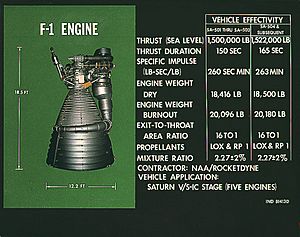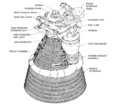Rocketdyne F-1 facts for kids
The Rocketdyne F-1 was a very powerful rocket engine. It was used on the famous Saturn V rocket. This rocket helped send astronauts to the Moon! Even though the F-1 engine had some small issues during testing, it always worked perfectly during actual space flights. Its first flight was on the Apollo 4 mission. This amazing engine was also considered for other large rockets that were being planned.
Quick facts for kids F-1 |
|
|---|---|

Information about F-1 rocket engine (in United States customary units).
|
|
| Type | Rocket engine |
| Place of origin | United States |
| Service history | |
| In service | 1967–1973 |
| Used by | Saturn V |
| Production history | |
| Manufacturer | Rocketdyne |
| Produced | 1959 |
| No. built | 65 |
| Variants | 2
|
| Specifications | |
| Mass |
|
| Length | 5.6 metres (18.5 ft) |
| Diameter | 3.7 metres (12.2 ft) |
|
|
|
| Engine | 6,770,000 newtons (1,522,000 lbf) |
| Propellant | RP1/LOX |
Explore More
Images for kids
-
Wernher von Braun with the F-1 engines of the Saturn V first stage at the U.S. Space and Rocket Center
-
F-1 on display at the U.S. Space & Rocket Center in Huntsville, Alabama.
-
The Vulcain for the Ariane 5 rocket uses a similar cycle design to F-1 engine, with the turbine exhaust gases piped directly overboard.
-
Unflown F-1 engine on display at Pratt & Whitney (now Aerojet Rocketdyne), Canoga Park, Los Angeles
-
F-1 engine on display at INFINITY Science Center
-
Recovered F-1 engine parts on display at the Museum of Flight in Seattle.
-
Recovered F-1 engine injector from Apollo 12 mission on display at the Museum of Flight in Seattle.
See also
 In Spanish: Motor de cohete F-1 para niños
In Spanish: Motor de cohete F-1 para niños











